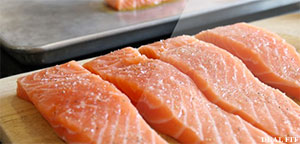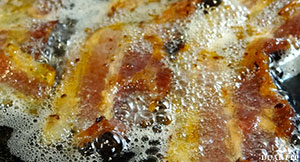By DualFit.com
Every living, breathing, walking, running, lifting person needs fat. For those of you sticking to a low-fat diet, you may not being seeing the results you want. But knowing the difference between good fats and bad fats can definitely help you reach your goals.

Fat is one of the three marvelous macronutrients. It is found in many foods either as good fat or bad fat. You may see the term "lipids" being used in place of fat. A lipid is just another way of saying fat. The human body needs fat for many reasons. It helps to cushion your organs, provides insulation, helps absorb the fat-soluble vitamins (A, D, E, and K), stores energy, and may be used by the body as fuel.
Fat is the densest of the macronutrients and provides the most calories, mostly because it stores the most energy. One gram of fat contains 9 calories in comparison with carbohydrates and proteins having only 4 calories per gram.
There are two main forms of fats, solids and liquids. Liquid fats, or oils, are fats that stay in a liquid form while at room temperature. They typically do not mix well with water. Solid fats remain solid at room temperature.
Yes, fat is good, and there re two types of good fats: Monounsaturated fats and polyunsaturated fats. These two types of fats are the good kinds because they play a role in raising your HDL cholesterol, or good cholesterol. Having high levels of HDL help to fight the body against heart disease, diabetes, cancer and other obesity-related illnesses.

Monounsaturated fats (MUFAs) have been shown to significantly decrease your risk of heart disease. MUFAs are also known to help decrease your belly fat. If you ever look at an ab diet, the majority of the diet consists of eating monounsaturated fats.
Examples of monounsaturated fats: Avocados, walnuts, almonds, sunflower seeds, flaxseed, olive oil, canola oil and dark chocolate.
Polyunsaturated fats are the other kind of good fat. There are two types of polyunsaturated fats: Omega 3 and Omega 6. Both have been shown to lower your LDL cholesterol, or bad cholesterol. LDL cholesterol has been linked to heart disease, diabetes, cancer, and many other deadly illnesses. The lower your LDL cholesterol…the better. Consume polyunsaturated fats to get that number down.
Examples of polyunsaturated fats: Safflower oil, sunflower oil, flaxseed oil, cold water fish and walnuts.
While your body needs a certain amount of fat to survive, consuming too much can cause a negative effect on the body. Eating high amounts of fat can ultimately lead to weight gain so it's important that you find a good balance between your fats.
These are the types of fats that you should stay avoid. The typical American diet makes that pretty hard to do, but try your best not to consume too much of these fats or you could end up severely overweight or with a life-threatening illness. The two types of "bad" fats are saturated fats and trans fats.
Saturated fats are a solid fat, solid at room temperature. They are bad because they are known to raise your LDL cholesterol. Remember, LDL cholesterol is your BAD cholesterol. You don’t want to have a high LDL.
Examples of saturated fats: Fatty beef, lamb, pork, butter, cream, cheese, and many other animal products. Vegetable sources include coconut oil, palm oil and kernel oil. Also found in baked foods and fried foods.

Trans fats are the worst of the worse. You want to limit your intake of trans fat as much as humanely possible. While monounsaturated, polyunsaturated and saturated fats naturally occur in many foods, trans fats do not. They are synthetically made in some lab by some Joe Schmo. Another name for trans fats is partially hydrogenated oils. They are called "hydrogenated" because what they do to create these fats is add hydrogen to liquid vegetables oils in order for them to become solid.
These kinds of fats have absolutely no positive effect on the body. In fact, your body would thank you very much if you never consumed trans fats again. They raise your LDL, lower your HDL, and put your body all out of whack. Consuming a diet high in trans fats will most likely give you a one-way ticket to heart disease.
Many, many foods in the modern American diet contain these evil trans fats. Why? Because they help to preserve the shelf life of food, taste good and are dirt cheap.
Examples of trans fats: Fried food, donuts, pies, pastries, cakes, cookies, crackers, pizza, chips. and all that other junk.
You should eat fat. Fat is good for you, if you are choosing the right foods. Eat a diet that contains the examples stated above under good fats and avoid the examples of fats stated under bad fats. It seems simple, but many people today still grab for those cookies or cakes. Your body deserves better.
Go into your kitchen and take a look at the ingredients list on the back of each food in your household. Whenever you see the word trans fat or partially hydrogenated oils, throw it out. I don't care if it's your favorite box of cookies or bag of chips, you shouldn't be feeding your body that crap. Next time you do your food shop, pick up the box of food you’re about to buy, read the ingredients, and scan for those two magical words. If you see them, put it down! Little changes will make a big difference in your life. Eat healthier, be healthier.
More From DualFit.com:
-- Nicky Jankovic: Fitness Model, Figure Champion And Exercise Scientist
-- HIIT: High Intensity Interval Training
-- Better Cardio Call: Track Or Treadmill?
-- Interview: A.J Jacobs, Author Of 'Drop Dead Healthy'
Popular Stories On ThePostGame:
-- Why High Heels Make Your Breasts Sag
-- The Truth About Swiss Balls
-- 5 Awesome Arm Curls You've Never Tried
-- The World's Coolest At-Home Workout








